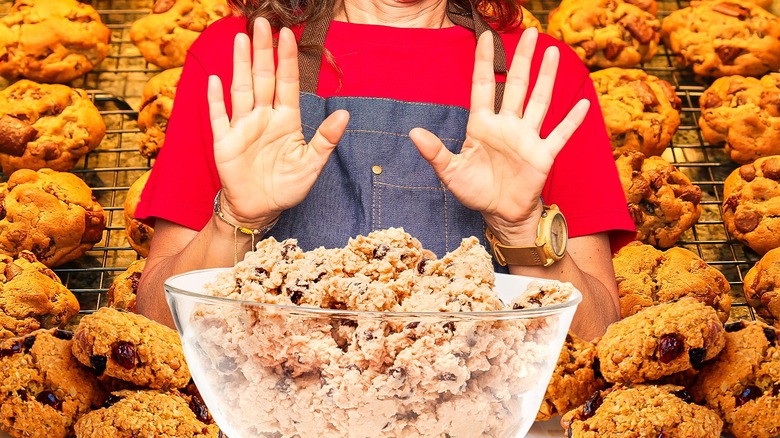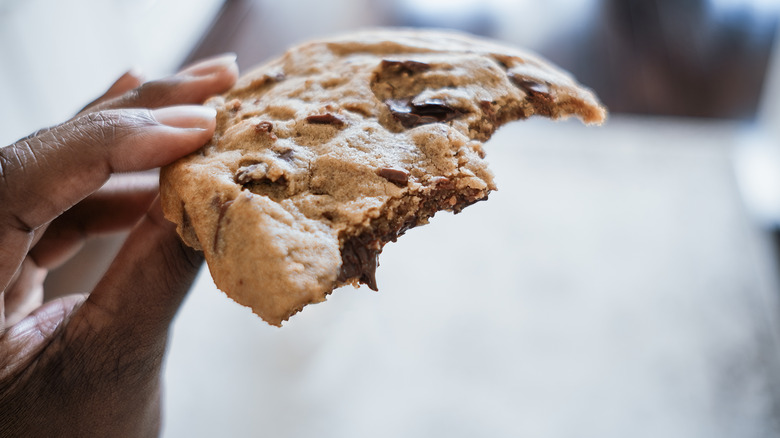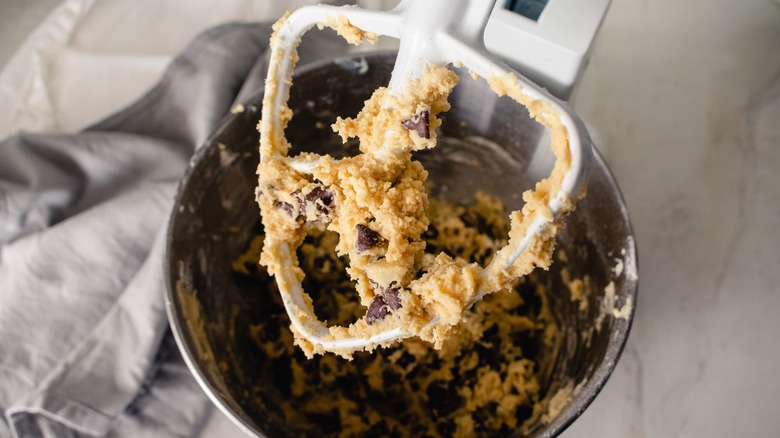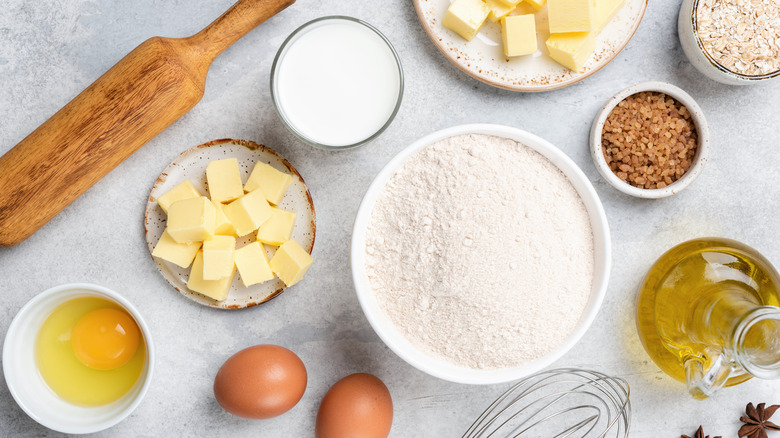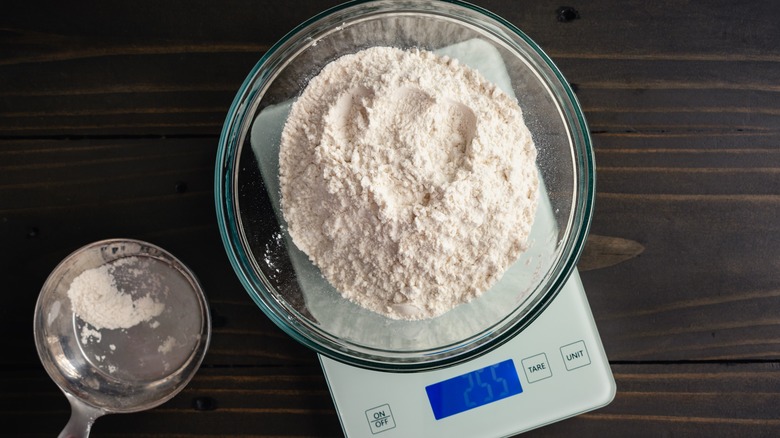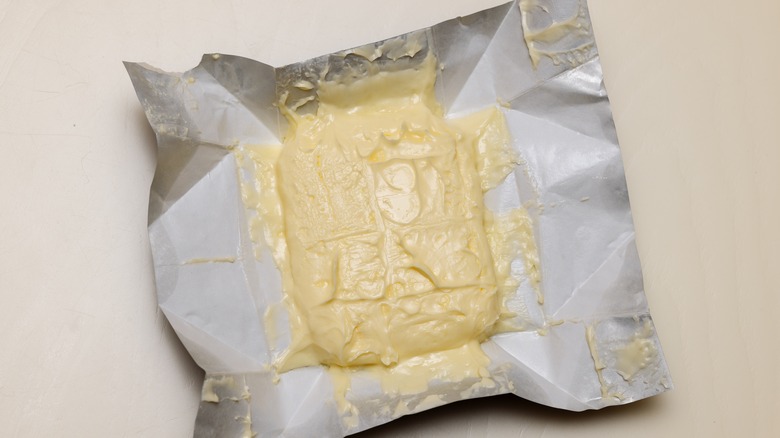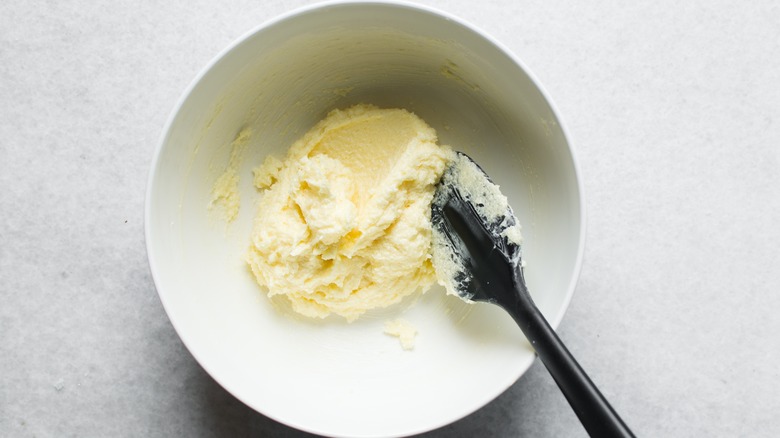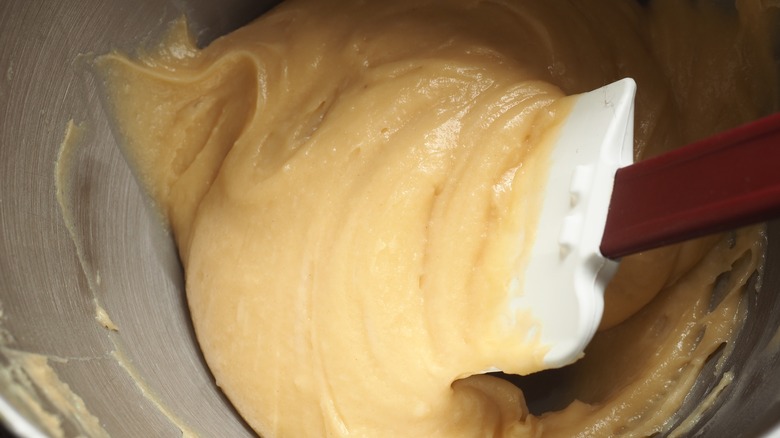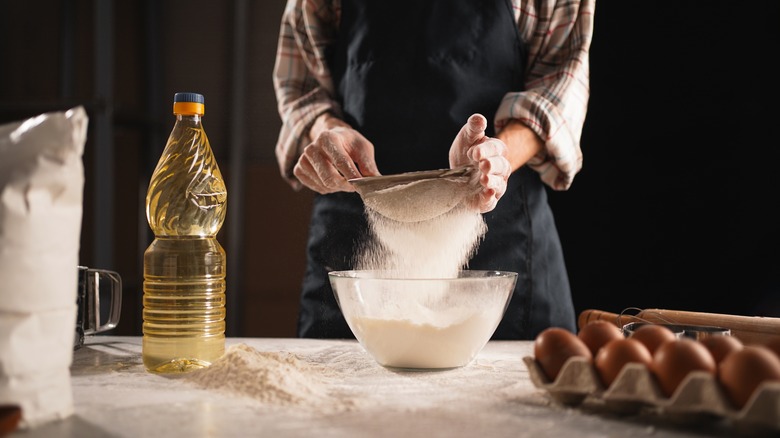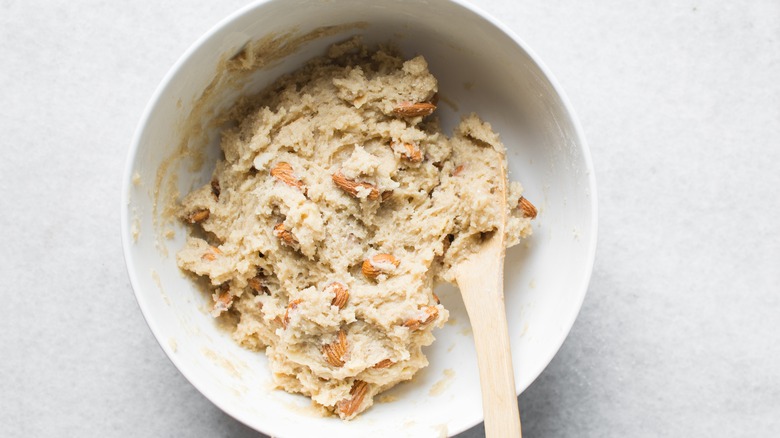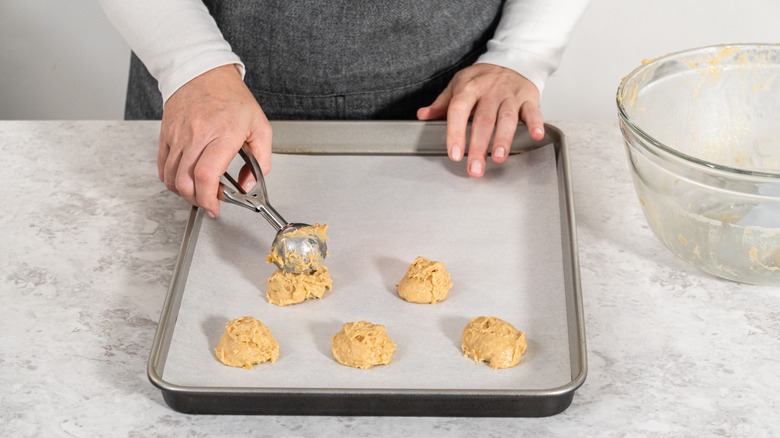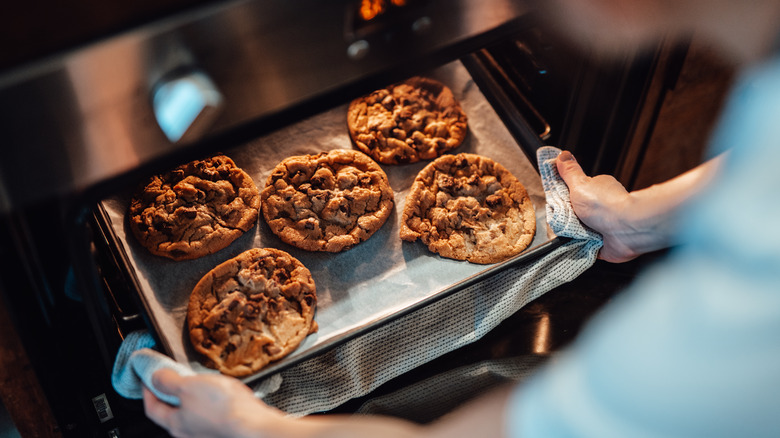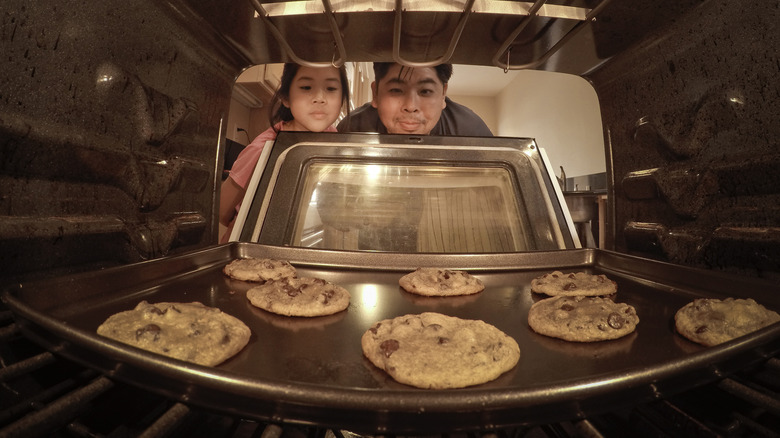12 Mistakes To Avoid When Baking Big-Batch Cookies, According To A Baker
If you're a home baker with a cookie recipe that all your friends rave about, there's a decent chance you've been asked to make a mass batch for a friend's birthday, housewarming, or other special occasion. We don't blame you for agreeing enthusiastically — after all, who doesn't want their baked goods to be enjoyed by a crowd? But if you've never made dozens of cookies at a time before, it can quickly become a mammoth task. Even worse, if you're unprepared, you might find yourself making several mistakes that could spell disaster for your huge batch of cookies.
As a commercial baker with plenty of experience baking large batches of cookies, I've learned a few things over the years that can make big-batch baking infinitely easier. At the end of the day, most of my tips come down to being prepared and planning ahead. When you're making huge batches of cookies, even small mistakes can have a big impact, and there's nothing more devastating than spending hours in the kitchen only to have your finished product turn out less than stellar. So the next time you get ready to make a massive batch of cookies, make sure you avoid making these common mistakes.
1. Not doing a test batch
If you have a tried-and-true cookie recipe, this first tip may not be necessary, especially if you've made the recipe dozens of times before. But if you're planning on big-batch baking a cookie recipe that you've never made before, this tip is vital to ensure your cookies come out looking and tasting as amazing as you want them to. At least a week before you're scheduled to have dozens of cookies ready, be sure to make a test batch of your new recipe. You could make a standard-size batch, or even halve it if you want to save your ingredients.
There are a few benefits to baking a test batch before you make your massive batch of cookies. First, if it's a completely new recipe, a test batch gives you the opportunity to familiarize yourself with the steps to baking this particular cookie. For example, if you're trying a new chocolate chip cookie recipe that uses browned butter and you've never browned butter before, you'll want to try your hand at it before browning pounds of butter at a time. Making a test batch will also let you know if you want to make any tweaks to the recipe, such as using a different type of chocolate, adding tahini to chocolate chip cookies, or even piping chocolate on top for an elegant touch.
2. Overfilling your mixer
If you don't know your stand mixer's capacity, you'll want to get familiar with it before you bake a huge batch of cookies. Most standard-size stand mixers fall in the neighborhood of a 4½ to 5½-quart capacity, which is perfectly suitable for making a single (maybe even a double) batch of cookies. If you're lucky, you might have a larger stand mixer that could allow you to increase your recipe size even further. But the one thing you don't want to do is overfill your mixer. Be prepared to make multiple small batches if you have to, and measure your ingredients accordingly.
One of the worst feelings (and I'm speaking from experience) is when you cream mass amounts of butter, sugar, and eggs in your stand mixer, and then adding the dry ingredients makes your bowl practically overflow. Don't fill your stand mixer beyond its capacity — this will make it more difficult to adequately combine your ingredients, and with thick cookie dough, you run the risk of overheating your mixer. Even though making a few smaller batches may seem like a pain, it will be easier in the long run than trying to figure out how to mix a huge amount of cookie dough when you don't have a bowl that's big enough.
3. Measuring as you go
It's easy to assume that making a big batch won't take as much time as making a smaller batch, since you're doing the same basic steps. However, when you increase the quantities of everything to make a big batch, it's only going to take more time to measure your ingredients. Even worse, if you're not used to baking big batches of cookies, you may find that you're unexpectedly short on an ingredient or two — and there are few things worse than being halfway through the baking process and realizing you need to make a trip to the store.
Fortunately, these problems are very avoidable with one little prep step: Measure out all of your ingredients before you start mixing anything together. If you want to be super prepared, measure them a day or two before so you have ample time to make a grocery run if needed. Having ingredients pre-measured will be a lifesaver, especially in a time crunch. It will also help you keep your workspace cleaner — rather than having bags of flour and sugar out on the counter, you'll have pre-measured quantities right in front of you, making the clean-up process easier later.
4. Using volume measurements
We hate to break it to you, but using volume measurements is the worst way to measure flour. While using volume measurements may work fine for a typical batch of cookies, when your measurements are larger, the margin for error is higher. For example, if you're measuring a single cup of flour, scooping it out of the bag or spooning it into a cup and leveling it yields imprecise measurements depending on how the flour packs into the cup. While being a few grams over or under probably won't make a huge difference in one batch of cookies, if you're scooping multiple cups and each is a few grams off, that can lead to a huge difference in your finished product.
Instead of using volume measurements for your ingredients, it's a good idea to invest in a decent kitchen scale and weigh each of your ingredients. Not only will this reduce your margin of error when making a big batch of cookies, but it will also make the measuring process easier in general. After all, have you ever lost count of cups or teaspoons when scooping ingredients into a bowl? Trust me — weighing your ingredients when making large batches of cookies is the way to go.
5. Quickly softening your butter
It's easy enough to soften small amounts of butter in the microwave, and you've probably found yourself trying other hacks to quickly soften butter at least once or twice. This is a fine way to go when you're making smaller batches of cookies. If you're trying to soften multiple sticks of butter in the microwave, though, it's likely you'll end up with some parts completely melted and some still chilled. To get the best results possible, you want your butter to be soft but still hold its shape — you should be able to easily press into it with your finger without it melting away or feeling too greasy.
The best way to uniformly soften butter is — like many other tips on this list — to plan ahead. For best results, pull the quantity of butter you'll need from the fridge several hours (or even a whole day) before baking. This will give your butter time to come up to room temperature, at which point it should be the perfect consistency to cream with sugar. If you're in the winter months or your house is otherwise cold, put the butter in a warm area of your house. If your oven has a bread proof setting, you could use that to adequately soften your butter as well.
6. Not creaming your butter and sugar enough
Creaming butter and sugar together for your standard-size cookie batch should take only a few minutes. It stands to reason, though, that higher quantities of butter and sugar will take more time to cream together. Consider this when you're making your cookies, and be cautious not to under-cream your butter and sugar. When it's finished creaming, it should look light, smooth, and a bit fluffy, and you shouldn't be able to see sugar granules in the mixture.
When you cream together butter and sugar, you start incorporating air bubbles into the mixture, leading to light, fluffy, well-textured cookies. Under-creaming will lead to a denser product, which isn't always a bad thing — but in general, you want to achieve a light, airy texture after creaming. The air bubbles present when sugar and butter are adequately creamed together help filter heat evenly through the cookie while baking, ensuring you have uniform cookies that don't feel too heavy or dense.
7. Not scraping your bowl down regularly
We've already talked about not overfilling your mixer, but your mixing bowl may still get pretty full when making a big batch of cookies. It's okay to mix large quantities at a time, but a concern will always be making sure your ingredients are adequately mixed. While you've probably found yourself needing to scrape down your bowl even when making smaller batches of cookies, bowl-scraping is an essential practice during every step of mixing large batches of cookie dough.
When you're creaming together butter and sugar, stop every minute or so to scrape down your bowl, and then resume creaming. Once you're beating in your eggs, stop halfway through to scrape down your bowl, and continue beating. When mixing in your dry ingredients, stop every minute to scrape down the still-dry portions of dough. Make sure you don't go too long without scraping down the bowl while making your cookie dough; otherwise, you may find yourself trying frantically to incorporate pockets of unmixed ingredients at the last minute. This could lead to some parts of your dough being over-mixed and others not being mixed enough, which can yield cookies that aren't uniform.
8. Not sifting your dry ingredients together
Sifting flour before measuring it is a vital step when making delicate pastries like cakes. You're probably not accustomed to sifting dry ingredients when making simple cookie recipes, but this little step can be a lifesaver when it comes to getting all your ingredients well-incorporated, especially vital ingredients that are used in small quantities, like baking soda and salt.
After you've weighed out all your dry ingredients, pour them into a fine-mesh sieve and sift them into a clean bowl or directly into the bowl with the rest of your cookie dough. Not only will sifting your dries help ensure the baking soda and salt get fully incorporated, but it will also keep the flour from clumping up into dry pockets when you're mixing in your dry ingredients. That way, it will take less time to fully incorporate your dries, which will help prevent making our next common big-batch cookie mistake.
9. Over-mixing your dry ingredients
Even though you absolutely want to make sure your ingredients are all evenly combined, there's a fine line between adequate mixing and over-mixing your cookie dough. Over-mixing dough can have disastrous consequences for a few reasons. First, over-mixing cookie dough can incorporate too much air into your dough. This will cause your cookies to seriously inflate in the oven and then fall, leading to dense, tough cookies. Over-mixing dough can also cause the gluten in your flour to start developing, which will also lead to a tougher final product.
To keep from over-mixing your dough, you'll want to — you guessed it — plan ahead. As we've already mentioned, make sure to scrape down your bowl every minute or so when you're incorporating your dry ingredients so you aren't rushing to mix in excess flour at the last minute. If you're adding optional ingredients at the end of your mixing process, like nuts or chocolate chips, start adding them in slightly before your dry ingredients fully incorporate, and let your ingredients finish mixing.
10. Shaping them by hand
When you're making a batch of cookies for yourself, it's perfectly fine to shape them by hand if you want to. But this is the wrong move to make when you're big-batch baking cookies. Firstly, we have to mention the issue of hygiene — it will simply be more palatable for all your cookie consumers if you shape your cookies with a cookie scoop, rather than using your hands.
Aside from health concerns, there are a couple of other valid reasons to use a cookie scoop to shape your cookie dough. Perhaps the most obvious one is that using a cookie scoop to shape your dough will make your cookies look as uniform as possible post-baking. Another reason to use a scoop has to do with temperature. When the warmth of your hands comes into contact with the cookie dough, it can cause the butter to start to soften, which could lead to your cookies spreading out too much and getting unpleasantly crispy around the edges.
11. Baking right after mixing
Planning ahead will once again serve you well when it comes to this big-batch baking tip, whether you want to bake all your cookies off at once or freeze them to satisfy your cookie cravings. Avoid baking your cookie dough right after mixing, especially if it's warm in your house. You don't need to stick them in the freezer before baking, but you'll want to put your shaped cookies in the fridge for at least an hour or two before baking.
This is another tip that shows how much cookie dough temperature matters. Putting chilled cookie dough straight into the oven helps the cookie bake uniformly all the way through while retaining its shape, giving you better chances of ending up with a thick, chewy, gooey cookie. Baking off warm cookie dough, on the other hand, can cause your cookies to spread and become thin and crispy — not a bad thing if that's what you're going for. Another advantage to chilling your cookie dough and baking it straight from the fridge is that your cookie dough will enter the oven at the same starting temperature, so all your dozens of cookies can turn out as uniform as possible.
12. Not keeping an eye on the oven
We get it — you've spent hours measuring and mixing your ingredients, and sticking your cookies into the oven feels like a relief. Before you stop and take a breath, though, there's one last thing you have to do, and this is crucial — keep an eye on your cookies as they're baking.
There's a lot to think about here. First, if you're baking your cookies on two different racks, you'll probably want to switch the trays halfway through baking to ensure all your cookies bake evenly. Having more trays of cookies in the oven may also necessitate more baking time, especially if you're pulling your cookie dough from the fridge. You'll also want to give your oven adequate time to preheat fully. Rather than sticking your cookies in just after your oven's preheated, give it another 10 or so minutes to make sure your oven is evenly and adequately heated.
